JOMO.
Apparently, it’s a term, a word, an acronym that has been around for awhile, though it’s one I only heard for the first time last night at a party of mostly Burners-not-at-Burning-Man who had gathered–as happens often–on “Burn Night” (the last Saturday during Burning Man when The Man burns). JOMO is the JOY of Missing Out, and I must say, yes, I had a little JOMO last night after a day of watching event-focused weather reports, reading various news articles on the situation there, tuning into BMIR radio for updates, and getting a flood of mud-filled Burning Man photos in my Facebook feed.
Now, I’m certain those attending Burning Man in this rain … and this mud–this thick, slick, slippery, cement-y, adheres-to-everything-and-won’t-let-go mud–will all have Big Memories. They’ll all have Epic Stories to tell. And they’ll all, likely, have harrowing, sometimes horrible and maybe even horrendous experiences and difficulties to overcome.
And I’m certain many people will have come-to-Jesus moments in having to accept *what is* for there is nothing they can do but accept their circumstances and the limitations on their movement; to be humbled by Nature in her simple form of rain–rain upon a flat, lake bed of hard talc which turns cement-like when wet; and to be a little scared about food storage and supplies, water … and how they are going to evacuate their bowels in an environment where 1) they might not be able to get to the porta-potties and 2) they are likely already dealing with portos filled to the brim with the accumulated excrement, urine and blood of so many of their fellow festival-goers.
I’ve said it before and I’ll say it again, for all that people stress about the heat at Burning Man, “Take a layer off, put a light scarf over your shoulder or a hat over your head to protect yourself from the sun, or place a cooling towel around your neck. (They work great!) Yes, it can be unbearably hot at times, but it’s more bearable in the shade or in how you dress and protect yourself. And you can always chill during the day and adventure at night if the heat bothers you so.”
I’ve said it before and I’ll say it again, for all that people stress about the dust at Burning Man, “It’s glorious. You’ll come to understand that in time. Yes, protect yourself, always. A dust mask and goggles need to be on you at all times when not at camp, and preferably there, too, simply as your default. It is intense, but you will survive.”
I’ve said it before and I’ll say it again, for all that people stress about the heat and dust at Burning Man, “It’s the cold you want to concern yourself with. It’s the cold desert nights. And the cold desert mornings. And the times when the days are not hot and stultifying but cool and windy and cloud-covered. Be prepared for those times, too.”
But of all the things few give attention to and the one thing for which preparing is difficult yet necessary, it’s the rain. Simply on a personal level being both wet and cold for an extended period of time (wet shoes, wet socks, wet pants, wet hands, wet everything) plus cold temperatures … well, that can be some misery-making.
rain is a pain
More importantly, the rain — whether a bit of pittering and pattering, or a dumping of some overhead clouds — changes everything for everyone, everywhere, all at once. Rain changes the conditions of the playa, the ground, the land upon which all people walk, all bicycles are pedaled, and all vehicles must roll.
Each step, each rotation of a bike tire ,and each yard a vehicle moves concurrently lifts up the thick, wet, clay-like “mud” and adheres in an accreting, accumulating, never-gonna-let-you-go kind of way to whatever just pressed into it and lifted up. Rain makes walking difficult, as one’s shoes become heavier and more unbalanced and unwieldy with each step; rain makes bikes–the personal mobility go-to choice of tens of thousands of attendees, something that must be pulled along and dragged (or maybe even — gasp — temporarily abandoned) as the tires become quickly covered and the bike becomes unpedal-able; the rain makes larger vehicular movement–depending on how much rain has fallen, how it puddled and where, and how it seeped into the once drier-than-dry talc-like playa surface turning everything silty, slippery and squishy–difficult for vehicles as the mud accumulates around tires and axels and undercarriages of vehicles; it makes it dangerous, destructive to the seemingly barren (but not) ecosystem of phytoplankton, fairy shrimp and other small-yet-critical life form. In many cases, even high-powered 4WD vehicles have a hard time navigating the wet, muddy surface.
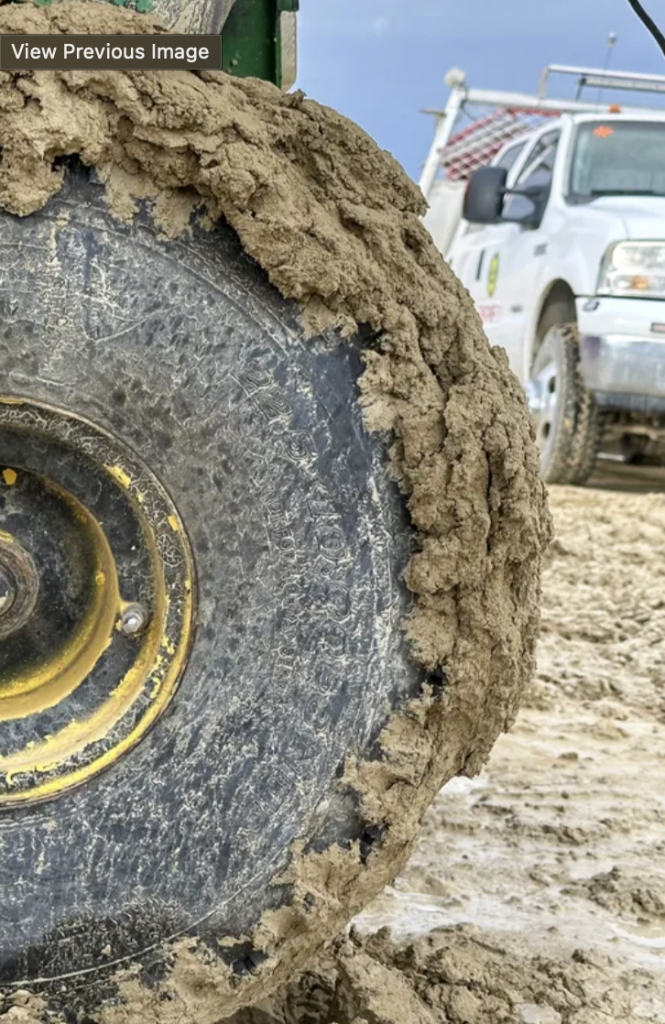
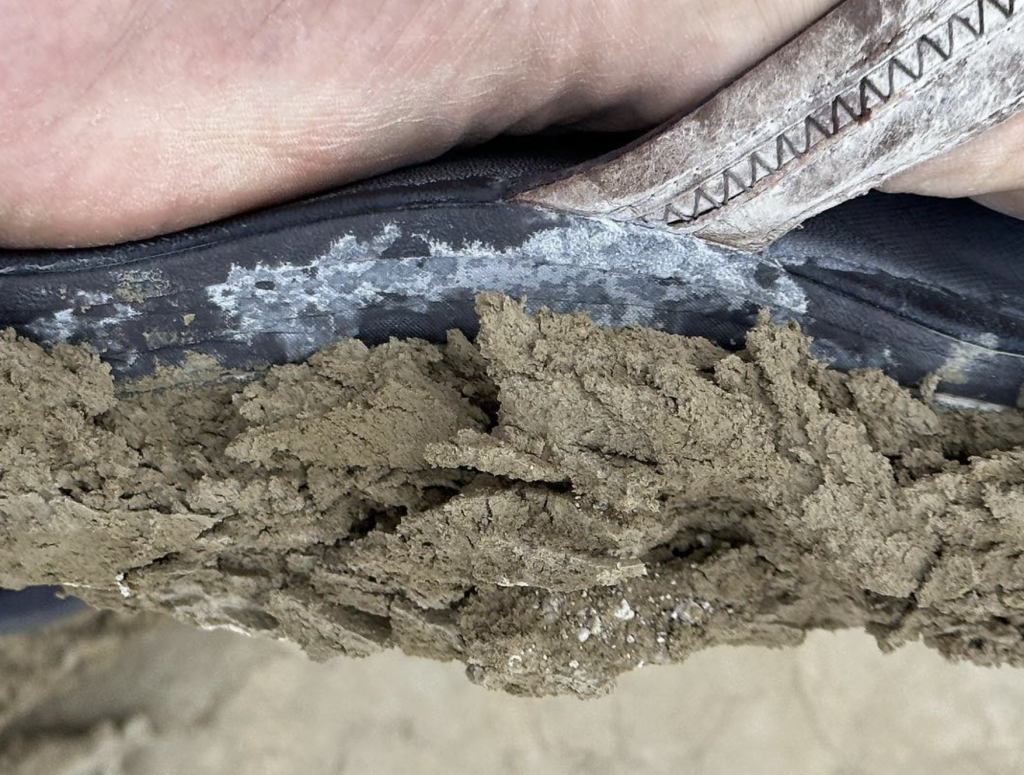
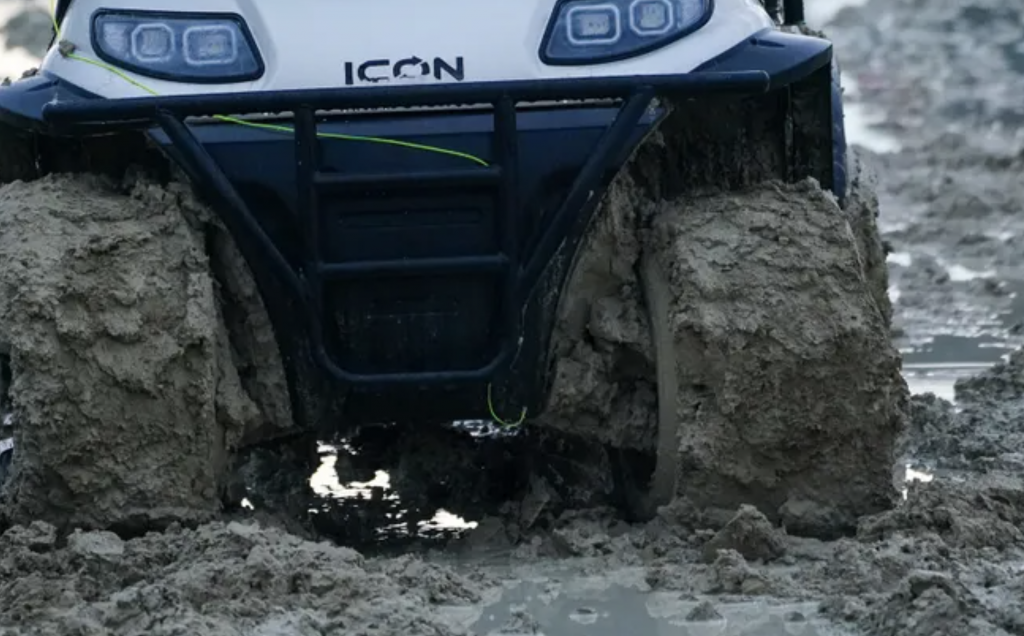
stop, halt, do not move
Vehicular movement is, essentially, stopped when it rains. Mostly by the mere logistics of it, but also officially by the organization, BMorg or The Borg as it is sometimes called, and the orchestration of the organizers, the DPW, the people managing the gate and entrance, and those interacting with the BLM staff (which, interestingly–especially for BLM security, were sparser than sparse for this event in 2023 as many were called in for emergency work in Lahaina, Hawai’i and Baja California after Hurricane Hilary came through).
When vehicular movement is halted, the gate IN to the event closes. In 2014, people who had traveled for hours, their cars packed to the brim, excited to enter the event, were turned around and told to go back to Reno and come back the next day. No cars on the playa until the playa had dried. (Thankfully, that year, all our camp members were inside the event when the gates were temporarily closed.) But it wasn’t just ingress impacted. It was also egress. If you needed to leave then, for whatever reason, the answer was, “No, not now. Tomorrow, starting at (whatever) time.”
Not being able to arrive and get in, or to leave, when one was hoping to, when one has been planning for this trip for (probably) months, and where one has likely prepped and provisioned within an inch of their life … and to be turned around– that, I’m sure is a disappointment, and a hassle. It’s one fewer day at the event. Or for those wanting, or needing, to leave, perhaps a missed flight or missed work meeting or missing their kids’ play back at home, these could be disappointments. Okay, they’ll be a day late, or a bit behind on their schedule, but, for most, such events are probably mere annoyances and a bit of a bummer. Not life-threatening of world-changing.
But when the time frame of stopped vehicular movement goes from 12 or 18 hours to 36 hours, or more, as it is now, other issues crop up–namely and mainly, the porta-potty servicing trucks. And ice deliveries. Yeah, ice, too–both the method by which food is kept cool and, for many, an additional source of water, once melted, for various and sundry uses. (Sunday morning update: I just saw a post on Facebook saying 400 portos had been cleaned.) Still, people are being encouraged to conserve and use wisely their food, water, ice and power. It’s gonna be a longer-than-expected haul to get out. Plans will need to be revised.
Many camps have become larger over the years, and groups have pooled resources together; many camps are reliant on gray-water removal services to come and empty their 250-gallon containers of gray water. Or black-water dumping services for the many RVs. What happens when those service-providers can’t access camps? Where is the excess gray water put? What happens when an RV’s black-water tank is filled to capacity? What happens when people can’t walk to Arctica to buy ice, or when ice sales are limited to conserve resources for all?
time to go
And camp strike?
When it’s time to not just pack down all one’s personal gear, personal items and personal possessions, but also time to pack down the camp’s infrastructure, the camp’s kitchen and the camp’s various inventory of things and bits and pieces into containers and bins and boxes so that items can be found and used yet again–that’s going to be a challenge. Simply cleaning off the extra, adhered, cement-like, don’t-wanna-go-anywhere-anytime-soon mud will be a challenge. Some people will be antsy to go home as soon as possible once the gates open and may either, from personal frustrations or true need to get home for work or family or medical reasons or whatever, focus more on self than others.
One of the no-no’s at Burning Man is dumping water–even “regular,” not-gray water–and one of the reasons given is that dumped water tends to create small puddles, which create divots, which impact the playa surface and ecosystem for years if not decades to come. Now? With all this …? It’s Divot City. That’ll be something. MOOP sweeps to get all “Matter Out of Place” into trash bags? Yeah, that’s gonna be something when many accidentally dropped lighters, or a used tissue that fell out of someone’s pocket or maybe even a beloved piece of jewelry fell to the ground and got twisted up in the mud … yeah, it might not be the cleanest playa ever. And DPW–the crew that comes in months early and stays months after to do the final cleaning and the final putting away of all the things large and small, I imagine that’ll be quite challenging this year.
And I imagine the roads for Exodus and leaving, once opened, will be fuller than full. I imagine some cars and vehicles may get stuck and be difficult to move. And I imagine the road out and time out (usually softened and lightened by people leaving the event anywhere from Friday night through late Sunday evening after the temple burn) will likely be crushed by the weight of so many others trying to leave at the same time–everyone all the more exhausted, all the more “just ready to be anywhere but here” and all the more anxious to get out amidst of sea of equally anxious others.
Some people will walk to the nearby road (not a short distance and not a small feat), leaving behind their gear for others to ferry home.
Some people who’d planned to leave by plane, or by bus on Sunday morning, may find their ticket out, their way out, not available as planned, or delayed even more by the back up and build up of people needing to get out. Some people may get frustrated, or pushy or self-focused. Some might.
burning bright
And yet …
This is what I know about burners. They (we) thrive in adversity and challenge. They (we) overpack to the gills and come prepared for disaster, difficulty and danger. They (we) come to That Thing in the Desert still ready to dance when the dust kicks up something fierce; still able to feed hundreds of strangers Shabbat dinner on a Friday night; still wanting, willing, ready and able to play their music at their DJ setup so others can dance all hours of the day and night; and still, as ever and always, have random connections, deep conversations and intimate moments in seeing the raw humanity of others as they thrive and come alive in challenging circumstances.
I know they (we) live–particularly there, in the desert–by the 10 Principles of which Communal Effort, Civic Responsibility, Gifting, Radical Self-Reliance and Immediacy are just a few.
I know people will be fed with the excess and largesse others brought to share. I know those with power banks will help others get their phones charged to help people communicate with loved ones, airlines, work colleagues and more. I know someone is still offering manicures and a nice hand-soak before, maybe even a hand massage, too. I know someone is still offering the workshop they planned to do, or an arts-and-crafts experience with all the supplies they brought. I know someone is still lighting their dragon staff on fire and performing beautifully in the mud, the light of the fire reflecting at night in the puddles of water on the ground. I know people are still being kind, and helpful and considerate. I know people are still having fun and making the most of it, and experiencing themselves pushed beyond any limits they could have previously imagined and still finding their emotional center, still making sure they brush their teeth, and still respecting the playa by not dumping their gray water.
I know the organization–BMorg and its many players–have spent countless hours imagining various disaster scenarios, planning out how to respond, how to communicate, what to do. I know the organization is responding, adapting and putting in place countless disaster-scenario plans and communicating with event-goers through BMIR radio, rangers, websites updates and more. I know they’re bringing in emergency mobile cell towers to place strategically and well. I know they are now hiring many buses to ferry to Reno those who can and do walk all the way to the black top, the asphalt, the road outside of Burning Man–and this is all free of charge. Provided. Given.
I know these things. I await the stories. I marvel at our community, the people, the culture, the better-for-the-experience impact this event will have on the individuals, the camps, the organizers and the culture.
And, JOMO. I’m glad I’m not there this year.
I have had epic experiences in my life. I will have more. I don’t need to have each and every one of them possibly available–just the ones that come my way; and for whatever combination of reasons, this wasn’t my year to go, and I have no FOMO, rather, a bit of JOMO. (I’m sure, too, had I been there, that would have been perfect, too.)
I look forward to seeing more photos as people post them now and after they are home, dry and showered. I know the interwebs are going to be filled with YouTube videos and images from this muddiest of muddy years. I’m sure I’ll be hearing stories, both wonderful and wacky, from those who were there this year. And, yeah, JOMO. I’m good having missed this one.
To all of you still there, peace, blessings and may you once again (and soon) be surrounded by dust and less mud.
from the comfort of your dry home
Here are some photos I found online, on Facebook and in various tweets and such.
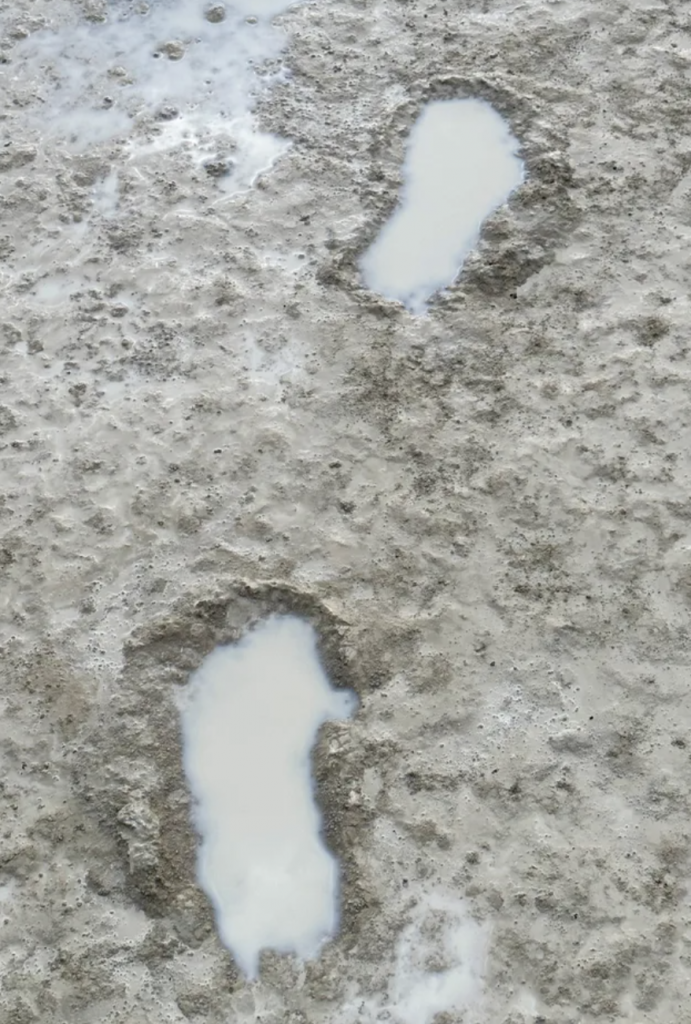

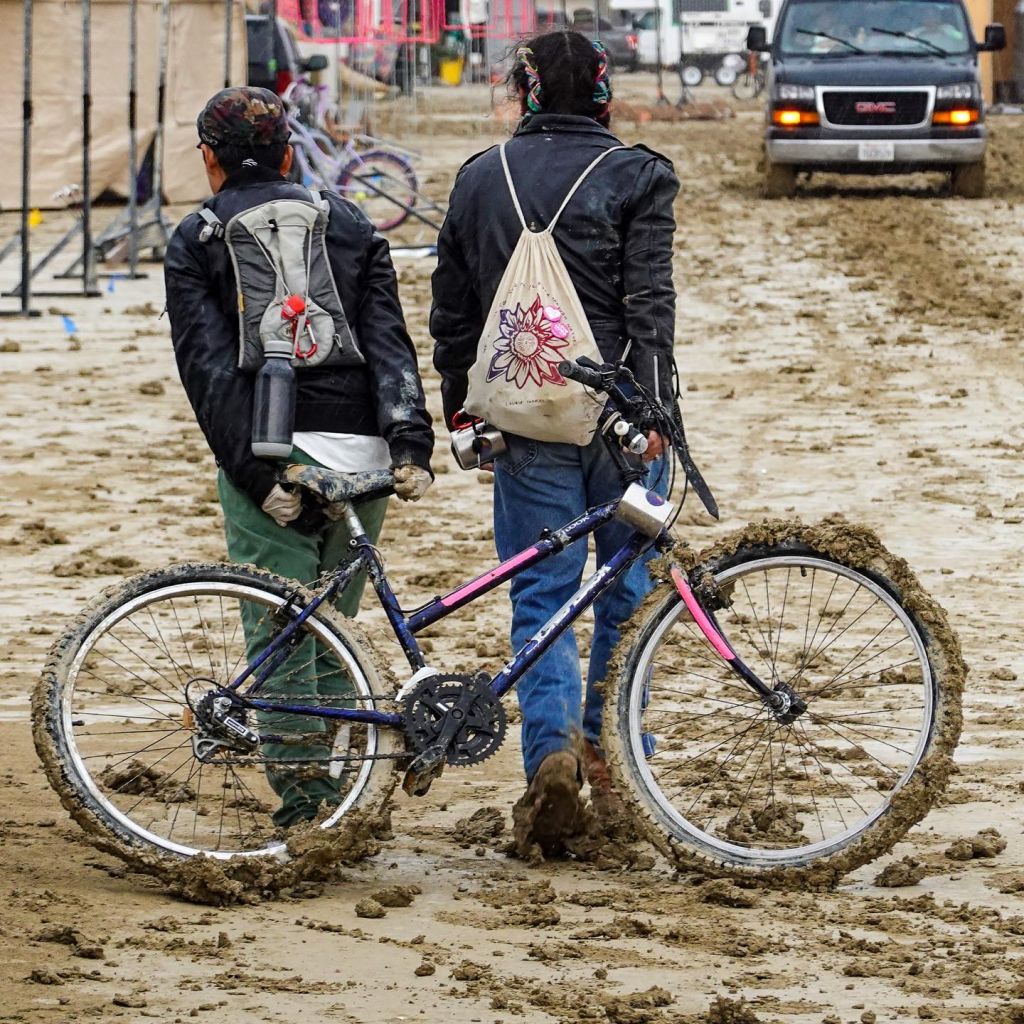
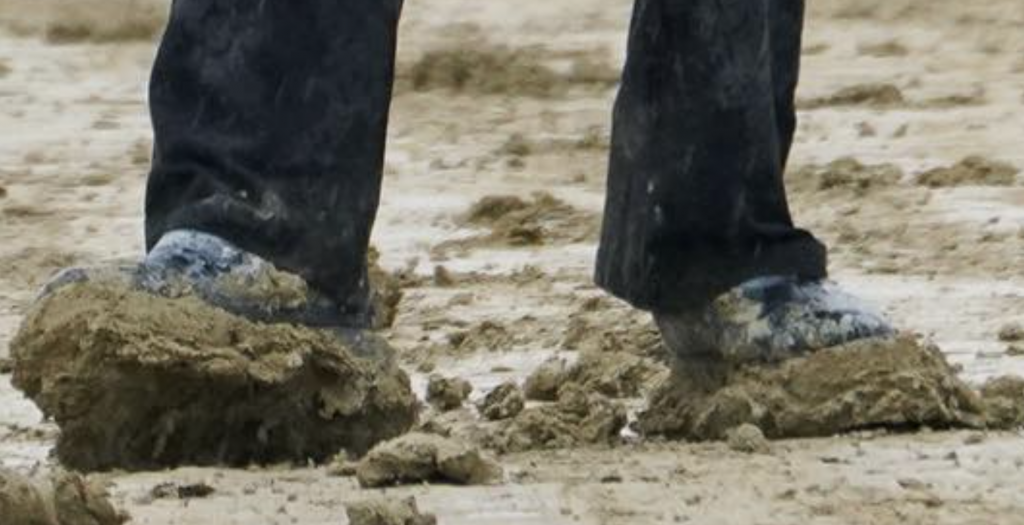
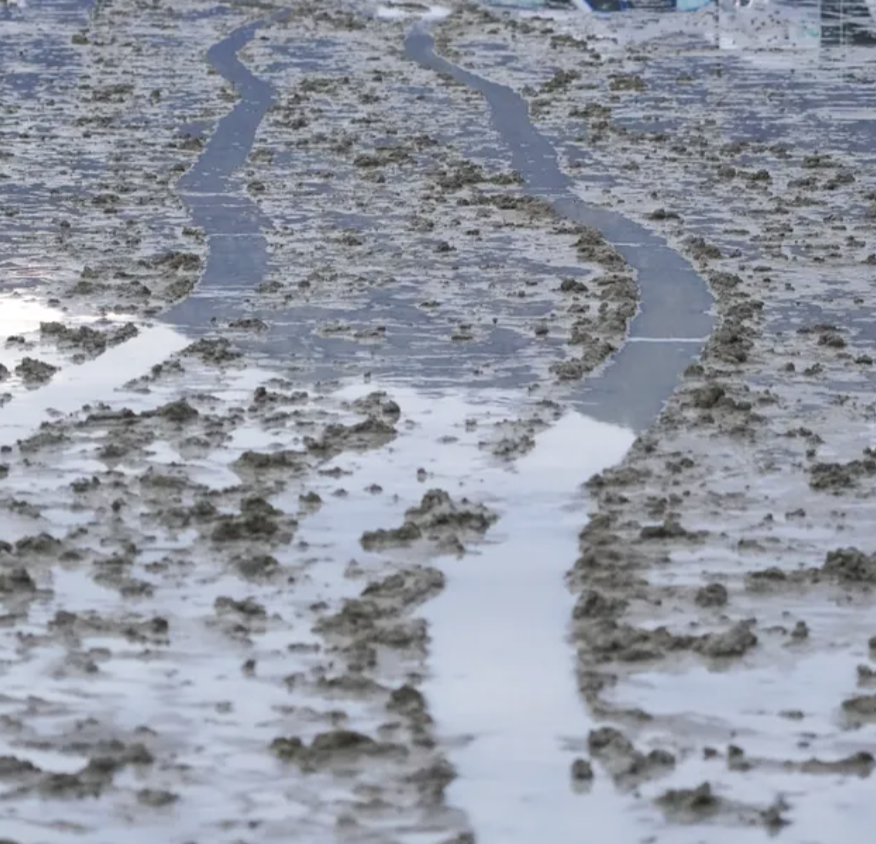





2 Comments
Jejd
Stop with the fake news. I was there and it wasn’t that bad. Left today and exodus was 35 minutes. Easy. Yeah it it lousy not being able to bike but events were still happening and we had a great time.
Jessie Newburn
What “fake news” did I post? I was talking about considerations, issues, logistics with rain. Not reporting. And if you read to the bottom of the post–not that you’re required to–I rather extoll the awesomeness of burners and burner resilience.